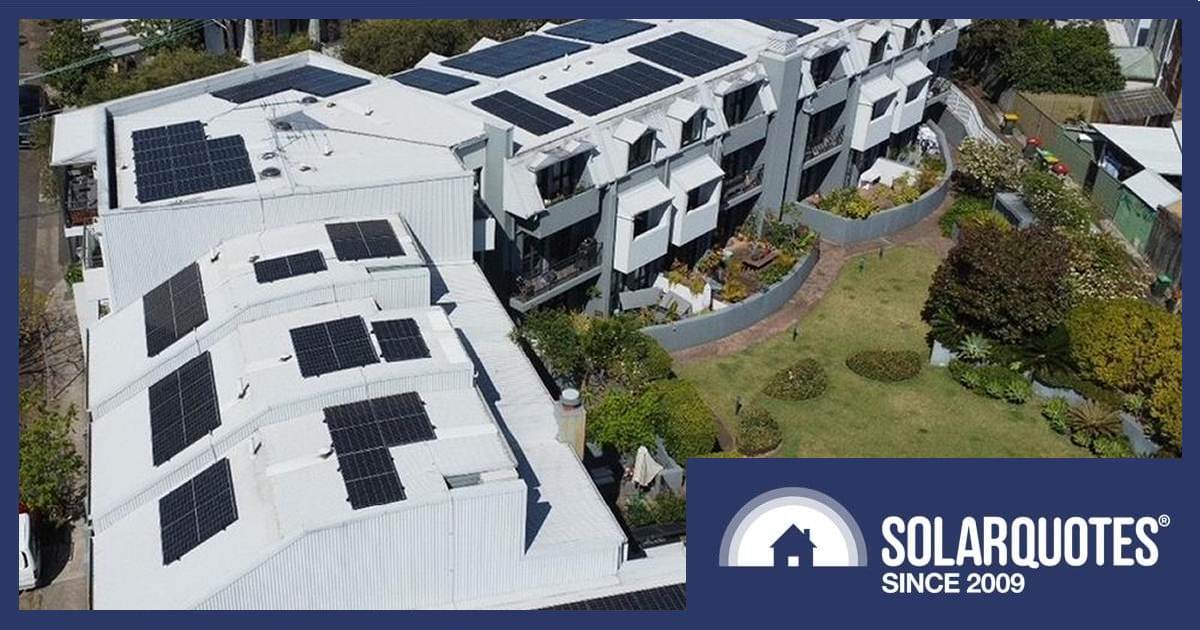New South Wales’ Solar for Apartment Residents (SoAR) grant initiative has been extended for an additional four months, and the first shared solar system funded under the scheme is up and running thanks to home-grown smart-tech.
What Is SoAR?
The program is a $25 million initiative of the Federal and NSW governments to help fund the installation of shared rooftop solar systems on eligible apartment buildings and other multi-unit dwellings across the state. It provides up to 50% of the cost of eligible systems, with a maximum grant of $150,000 available per project. SoAR is part of the Australian Government’s $100 million Community Solar Banks initiative.
While individual apartment residents can’t apply for SoAR, they can encourage their strata committee to.
SolarQuotes’ Max took a look at SoAR earlier this year and further information is available on the NSW Government’s website.
SoAR Progress To Date
Since launching in February 2025, the program has approved 33 applications, covering more than 1.1 MW of rooftop solar for over 534 apartments. The energy bill savings for beneficiaries is estimated to be up to $600 a year for each apartment says the NSW Government.
Program Extension Announced
Applications were previously to close on 1 December 2025 or when funding was exhausted, but it was recently announced the program has been extended until the end of March 2026 “to give people more time to apply”.
SoAR hasn’t exactly been a soaring success in terms of outcomes — yet. Even if each of the 33 approved applications received the maximum funding of $150,000 each; that works out to $4.95 million; so there’s plenty of money left in the pot.
However, hundreds of grant applications have reportedly already been submitted, with funding expected to be fully utilised by the extended deadline based on current application rates.
Switch Flicked On First Project, Uses Australian Tech
Residents of an apartment complex (pictured above) in the Sydney suburb of Newtown have the distinction of hosting the first operational rooftop solar installation funded by SoAR.
The 22-unit apartment building was connected via SolShare; solar-sharing technology designed, developed and manufactured in Australia by Melbourne’s Allume Energy.
“With our SolShare technology, both owners and renters are now sharing the benefits of solar – proving that any building can make it happen,” said the firm.
SolShare was the world’s first behind-the-meter solar sharing system. It allows a single rooftop solar system to be optimally shared by separately grid connected and separately metered units within that building. SolarQuotes’ Ronald delved into SolShare a few years ago, and Allume’s technology has continued to evolve since then.
Allume Energy has spread its wings beyond our shores and SolShare is now available in four other countries.
Apartment Solar Challenges
When announcing the launch of the SoAR program early this year, a joint press release from Minister for Climate Change and Energy Chris Bowen’s office indicated one in five NSW homes are apartments, yet only about 3.5 per cent of those are connected to solar systems.
The three main reasons installing solar power systems on apartment buildings is difficult are issues relating to:
- Shared roof space and ownership
- Strata and legal hurdles
- Metering and energy distribution
While installing solar panels on an apartment building comes with challenges, the benefits will be worth the effort when done right. SolarQuotes’ guide: Solar For Apartments: Options For Units & Strata takes a deep-dive into the issues and solutions (such as SolShare).
On a related note, another 5,000 rebates were recently made available for eligible apartment, unit and townhouse residents to install solar power systems under the third round of Victoria’s Solar for Apartments program. More than 3,200 households have installed solar panels under the Victorian program since it launched in February 2024. Round 3 applications are open until 5pm Thursday 30 April 2026.


 RSS - Posts
RSS - Posts



The strata scheme pictured above, which has 22 lots and was the first strata scheme to receive a NSW Solar for Apartment Residents (SoAR) grant of $54,000 actually had a 4 year 8 month journey to install solar.
Their building was identified as one of the top 200 strata schemes for installation of solar (from 2,500) in the Inner West council area by Inner West council’s Go Solar for Strata program in 2020.
The council funded a solar feasibility study in 2021 for the building.
The strata scheme got a 2nd solar feasibility study in 2024 in advance of the NSW SoAR grant being announced and then ran a solar tender to pick the right solar installer for their needs.
4 years and 8 months from when solar was first considered to when it was actually installed. A heroic effort by Inner West council, the strata committee, Owners Corporation, NSW government and the professional support that they received.
This scheme is let down by the lack of suitable product. Solshare is the only product that can be used and it has more limitations than benefits.
I don’t think it’s mentioned anywhere on this post or the government site that you linked to, but this scheme is still limited to strata schemes with a minimum of 3 residential lots and no more than 55 residential lots.
(It is noted elsewhere: https://www.energy.nsw.gov.au/households/rebates-grants-and-schemes/solar-apartment-residents)
Unfortunately that rules out many buildings, my own included. I get that large apartment complexes and towers are often unsuitable for solar, but I wish they’d come up with more flexible eligibility criteria.
Strata properties can be a nightmare to navigate, due to differing provisions in their title regarding the respective obligations of the Body Corporate Manager and the individual property owners. ie there can be differences between one development &. another quite separate development, just a few blocks away built by another developer..
Hopefully, future new developments will avoid many of the current issues, but even then problems caused by local council regulations can be an issue too.
No easy answers as yet I’m afraid, but at least some progress seems to be occurring